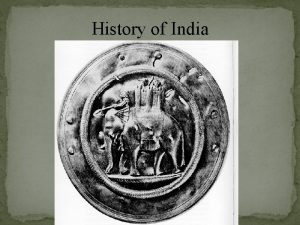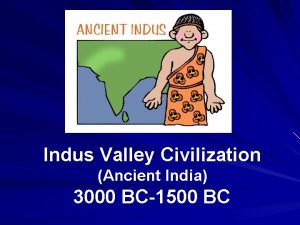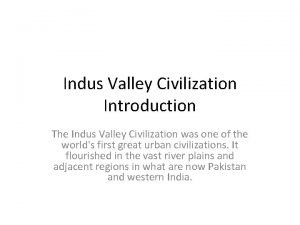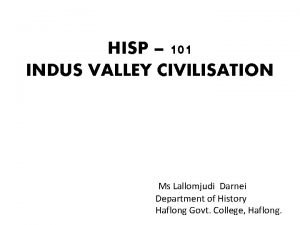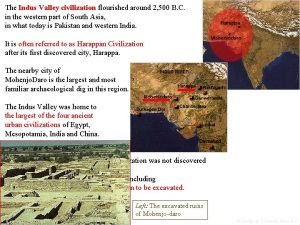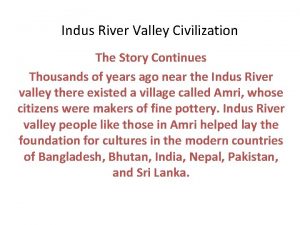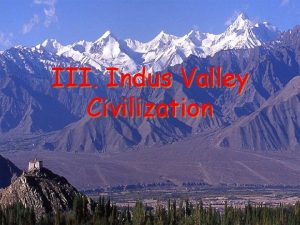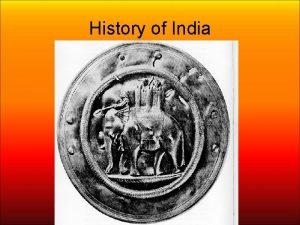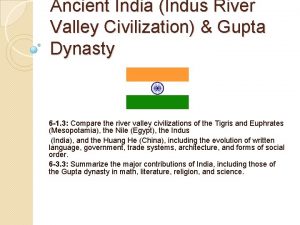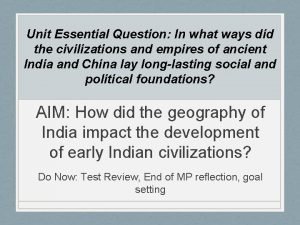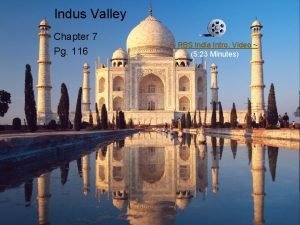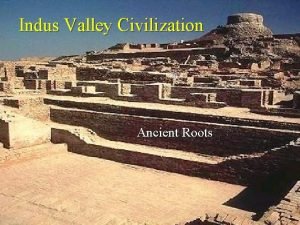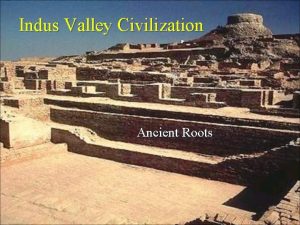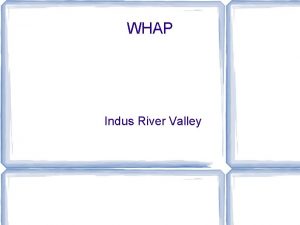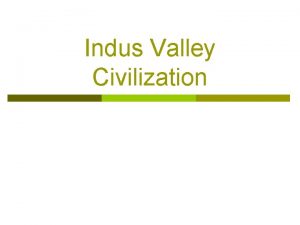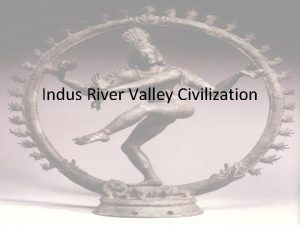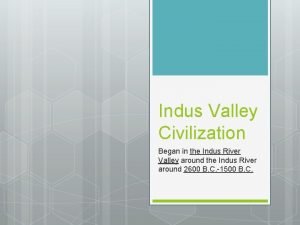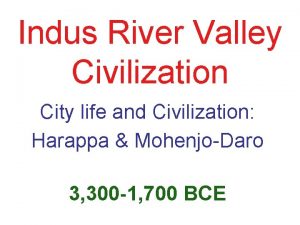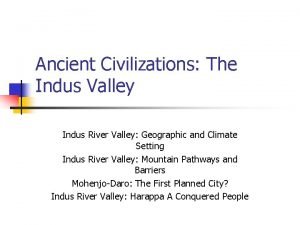PEOPLE AND LAND INDUS CIVILIZATION INDUS VALLEY Indus















- Slides: 15

PEOPLE AND LAND INDUS CIVILIZATION

INDUS VALLEY ■ Indus valley is one of the oldest civilizations of the world. the region where these civilization was developed had been irrigated mainly by River Indus and its tributary rivers. The signs of this civilization are found in Sindh at Mohenjo Daro and in Punjab along the River Ravi at Harappa (Sahiwal). About 1500 additional settlements and signs of this civilization have been discovered in Pakistan and Western India. ■ THE PERIOD OF INDUS VALLEY CIVILIZATIONS: The Indus Valley Civilization consisted of three periods: Primary Period 3800 BC to 2500 BC Middle Period 2500 BC to 1700 BC Last Period 1700 BC to 1300 BC During the primary period, urban life made a great progress. The art of handicrafts flourished. In the middle period, this civilization progressed well. Many new cities and villages were established. In the end of third period, the Indus Valley Civilization was inclined towards downfall. IMPORTANT CITIES OF INDUS VALLEY CIVILIZATION Mohenjo Daro It is an ancient city, situated in District Larkana (Sindh). This city was the most important center of Indus Valley. Indus River flows on its Eastern part. The signs of Indus Valley Civilization were first discovered in 1922 in Mohenjo Daro during excavation of the land. The things which have been found here are ornaments, clay, bronze, utensils, seals, carts, boats, toys, statues, spindles and skeletons of different animals. Bangles and beads of red clay are discovered from here which had been worn by ladies and children. Along with that precious gems, oyster shells made ornaments had also been used there. Harappa is the second most important city of the Indus Valley Civilization. From here, a lot of assets have been discovered of this civilization. Solid clay utensils, seals and system of measures and weights are included in it. Seals were made of solid clay, silver and copper. The pictures of elephant and humped bull are more prominent. Tools were made with bronze. Resemblance has been found in objects, which have been found in both cities, because both cities were the part of the Indus Valley Civilization.

Cont. . ■ RELATIONS WITH OTHER CONTEMPORARY CIVILIZATIONS Four most ancient civilizations of the world have been discovered in the world. Egypt, Mesopotamia (Iraq), Sumerian and the Indus Valley are included in it. The Indus Valley Civilization is considered contemporary of these ancient civilizations. The Indus Valley Civilization had trade relations with Southern Iran, Iraq, Egypt and Persian Gulf. The Indus valley among the Tigris & Euphrates, and Nile valley, are also called “Cradle of Civilizations”. It had also commercial and religious relations with Sumerian and Babylon. ■ CHARACTERISTICS OF INDUS VALLEY CIVILIZATION ■ Religious Beliefs: There have been found the portraits of gods and mother goddesses on stamps, which reflect that they used to worship the statutes and gods. Clay statues were also made for worshiping purposes. People used to consider the trees of holy values. The portraits of the bull, rhinoceros, lion and elephant have been found. The Indus Valley people buried their dead bodies as well as burnt them. ■ Social System: The social system was run under a regular administration. It was enforced to keep the system of weight and measurement correct and according to the standards. Sweepers were bound to keep streets and paths neat and clean. The society was divided into different sections. Town planning provides us information about it. Landlords and influential persons resided in upper parts in large and spacious houses. Separate quarters had also been reserved for servants. Majority of people had been poor. They lived in lower areas in small houses. Farmers lived in villages, while nomads wandered with herds of cattle in forests and plains. Artisans and merchants also lived in cities. Grand palaces, temples and tombs were not seen in cities. Jobs had been allocated among men and women. Women used to grind wheat, weave cloth and look after the cattle whereas cultivation, commerce and industrialization were specified for men. Cotton was cultivated in Indus Valley. Spindles also have been found in homes which indicate that weaving cloth was also a profession of those people. Statues of clay and printed cloth gave impression of textile industry. Women used to wear necklace, strings of beads and bangles for decoration. They were also used to wear "Lahanga" (long skirt). Men used to wear Shawl.

■ Cont. . Script: The people of Indus Valley could read and write. Their mode of writing was very interesting and complicated. A supreme system of writing was conducted in that period which had 400 symbols. Merchants, soldiers and political personalities used it. The experts of archaeology department could not find their meanings till now. Certainly, some experts have formed an idea, that these scripts Script (Writing System) consisted of more than one languages. Many corners of this civilization will be hidden until an expert does not read the words and the mode of writing of this civilization. ■ Agriculture: The soil of Indus Valley was fertile. The dependence of its wealth was upon trade and agriculture. The majority of Indus Valley Civilization consisted of farmers, who made the soil fit for cultivation purposes after cutting the forests. The crops were damaged due to seasonal rains. People retained the water to make banks on rivers for cultivation. The signs of crops which have been found from the settlements, it is said on this basis that the wheat, millets, barley, vetches, peas, Indian millet, rice, linseed, mustard-seed and cotton was produced. The signs of dates, melon and grapes have been found among fruits. ■ Peaceful Society: Few number of huge weapons have been found during excavation of cities. The rulers had not kept a large army or police. They maintained the relations with their neighbors and contemporary civilizations on the basis of peace. The common weapons which have been found during excavation, can be used only for hunting. This indicates that those people led peaceful life. No proof was found about assassination and plundering in that society. ■ The Presence of Bull: Cattle were the part of their lives. A large number of the skeletons of bulls have been found in Indus Valley. It shows that it was a common practice to rear the bulls. The bull was the most important animal in their society. Countless seals with bull's picture and clay toys have been found. The people also used the bull for transportation.

Cont. . ■ Commercial Activities: The trade of agricultural crops and minerals had been carried among cities and villages of Indus Valley. Internal trade had been happened by bullock-carts. Weights and scales of measurements have been found which are made of stones in quadrilateral shape. ■ Town Planning: The people had excellent knowledge of art of architecture. Cities and towns had been constructed with great technique and planning. Artisans had known the art of making and baking the bricks. They made the foundations of houses profound and deep, strong and also paid attention to exterior beauty. Houses had been built on the edges of the roads of city. Baked bricks were used in their construction. Every house had bathrooms which had been made towards outer street. Houses had more than one storey. Ladders had been used to go to upper storey. There was a reasonable arrangement of light and air in houses. Roads had been constructed with such a style in ancient Harappa that people could easily move among different towns and streets. Narrow gates had also been made from which a bullock-cart could pass easily at one time. It has been found by digging that a straight road was one kilometer long and nine meters wide. ■ Drainage System: There was an excellent drainage system of filthy water. Narrow and wide drains were made in proper order for the outlet of dirty water. Narrow drains had been covered by bricks and wide drains by large marble slabs. The stinking water had been brought together with wide drains, thus, stinking water was flowed out from the city. There is no example of any other city built in ancient period which has such a perfect facility for the drainage of the waste water.

Cont. . ■ Godowns of Grain: Mostly godowns of grain were situated on the bank of river in Mohenjo- Daro. The collected wheat from different areas was brought to godowns by the river routes and then had been sent to other regions. Concrete roads had also been made for this purpose. Solid floors had been made in 17 godowns. The salaries of government servants had been paid from that grain. The grain had also been used as currency. Huge godowns of grain were found in Harappa which had been used to store extra grain. ■ EVACUATION OF LOCAL COMMUNITY People of the Indus Valley were civilized, peaceful and developed, the Aryan assailants destroyed their graceful civilization. Aryans were Worriers. They had war-horses and excellent weapons. When Aryans attacked Indus Valley inhabitants, they could not face them. Aryans had pushed the local community towards South-East and became occupants. ■ THE DECLINE OF INDUS VALLEY CIVILIZATION Indus Valley Civilization gained a magnificent place by making a progress gradually. Its effects had been implemented upon a vast region. but suddenly it had disappeared in 1500 B. C. Its cites had been buried into earth. Its art, religion and culture were invisible from eyesight. There is a great difference among archaeologists to find the reasons about decline of the Indus Valley Civilization. It is estimated that both internal and external factors were involved in its decline. Some experts think that this civilization had come to an end due to natural calamities like earthquakes and floods. Some experts think that epidemics, diseases played a significant role to undo the Indus Valley Civilization. Drought was also major cause according to one opinion, because when rivers changed their course then supply of water had become impossible and this region had become barren. Well populated cities on the banks of rivers had been utterly destroyed. Some experts think that people intensively cultivated the land. They had finished the fertility of the land by cutting the forests. The pastures for animals had come to an end. Some experts consider that the trade had been finished with Mesopotamia and other contemporary civilizations. A major portion of income could not have retained due to this reason. When cities and colonies had been ruined. then people migrated to other places.

MUSLIM ADVENT ■ ARRIVAL-OF ARABS IN THE SUB-CONTINENT AND THE CONQUEST OF SINDH The Arabs were traders by profession. Basically, they used to visit different countries for their trade. They carried their luggage by boats and ships for Egypt and Syria. The Arabs had established their friendly relations with the people of these regions, due to trade. The Arabs had also delivered the message of Islam to the people of sub-continent. The Muslim traders had also settled at the coast of Sri Lanka and western India. REASONS OF INVASION OF SINDH In 703 A. D, The Governor of Makran Saeed bin Aslam was murdered and his murderer took refuge with Raja Dahir of Sindh. Hajjaj bin Yousuf demanded the hand over the murderer but Raja Dahir rejected it. A ship of Arab Muslims who had settled in Sri Lanka carrying trade luggage and gifts for Hajjaj bin Yusuf. When it reached near the coast of Debal, it was plundered by pirates. They imprisoned the children as well as women. Hajjaj bin Yusuf wrote a letter to Raja Dahir to recover the luggage from the pirates. In response to it, Raja Dahir wrote that pirates were out of his control. Hajjaj bin Yousuf infuriated and his young son-inlaw and nephew Muhammad bin Qasim was sent to Sindh with troops to punish Raja Dahir. CONQUEST OF DEBAL In 712 A. D. Muhammad bin Qasim reached Debal through Makran and besieged it. Debal was a famous sea-port of Sindh. Hajjaj Bin Yusuf wrote a letter to Muhammad bin Qasim, “Let Raja Dahir not cross the River Mehran (Sindh), face the enemy in an open area, keeping in view the organization of the troops, and win the favor of chiefs of Sindh”. Muhammad bin Qasim acted upon these instructions and succeeded in winning the battle. Forces of Raja came out of the fort and started fighting. The Arabs fought boldly entered over the fort captured the city. Raja Dahir fled away from the battle field and was killed later on. The Muslims got. Freedom from the prison of the pirates who were punished heavily. In 712 A. D, Sindh was conquered completely.

Cont. . ■ CONQUEST OF MULTAN The province of Multan was also included in the kingdom of Raja Dahir at that time. It was the center of trade and counted among strong forts. The ruler of Multan was the son of Raja Dahirs uncle. Having conquered Sindh, when Muhammad bin Qasim reached Multan, the Raja faced the Islamic troops b Lit saved his life by his escape. Muhammad bin Qasim found much wealth and treasure there. The major portion of the booty was divided among the soldiers and the rest was sent to Hajjaj bin Yusuf in Iraq. This conquest made Hajjaj bin Yusuf very happy. ■ EFFECTS OF INVASION People of Sindh welcomed Muhammad bin Qasim after the conquest of Sindh. Muhammad bin Qasim established the rule of equality and justice, which effected the Indian society very much. The Hindus of low caste embraced Islam by the moral influence and fraternity of Muhammad bin Qasim and his companions. The Muslims opened schools and Maddarasas to give education. Sanskrit books were translated into Arabic. After the conquest of Sindh, many scholars, and traders settled in Sindh. The Arab trade increased along the coastal areas of Baluchistan and Sindh. A number of religious scholars, writers and poets were emerged and they spread their knowledge. The Muslims learned Indian sciences like medicine, astronomy and mathematics. Sanskrit books on various subjects were translated into Arabic. During the reign of Haroon al Rasheed, a number of Hindu scholars were even invited to Baghdad. The establishment of Muslim rule also paved way for future propagation of Islam in Sindh and the adjoining regions. Later Sindh also attracted Ismaili missionaries who were so successful that Sindh passed under Ismaili rule. With the conquest of Lahore by Mahmud of Ghazni, missionary activity began again under the aegis of Sufis who were the main agents in the Islamization of the entire region.

LOCATION AND GEO-PHYSICAL FEATURES OF PAKISTAN ■ The official name of Pakistan is Islamic Republic of Pakistan. It covers an area of 796, 096 sq. km. Pakistan is located in the south of the continent of Asia. It is a country having fertile land, lofty plains, rivers and beautiful valleys. ■ LOCATION OF PAKISTAN: Pakistan is located between latitudes 23 o to 37 o North, and longitudes 61 o to 77 o East. India lies in the East, China in the North, Afghanistan in the North-west, and Iran in the West. The Arabian Sea lies in the South. ■ GEO-PHYSICAL FEATURES OF PAKISTAN: The land of Pakistan can be divided into five major parts with respect to physical features. 1. Mountain Ranges 2. Plateaus 3. Indus Plains 4. Deserts 5. Coastal Areas ■ 1. Mountain Ranges The high piece of land that has rocky, uneven and steep surface is called a mountain. Pakistan has following mountain ranges: i. Northern Mountain Ranges ii. Central Mountain Ranges iii. Western Mountain Ranges

Cont. . ■ i. Northern Mountain Ranges: These mountains are located in the north of Pakistan. These mountain ranges make the Northern borders of Pakistan secured to a great extent. They stop the winds coming from the Arabian Sea and Bengal Gulf causing snow-fall and rain. Their peaks are covered with snow throughout the year. This snow is a source of supplying our rivers with water throughout the year. We also get precious wood from these mountains. There are many healthy places in this region where people go for tourism. Among these places, Murree, Ayubia, Nathiagali, Kaghan, Lipa, Skardu, Swat, Kalam, Neelam, Bagh, Hunza, Chitral, Yasin, and Gilgit are famous. The northern mountain ranges include the following ranges: a. Himalayas (i. Sub-Himalayas or Siwalik Hills ii. Lesser Himalayas iii. Greater Himalayas) b. Karakoram c. Hindukush d. Mountains of Swat and Chitral ■ a. Himalayas Sub-Himalayas or Siwalik: This mountain range is in the east of the River Indus. It is the southern branch of Himalayas which stretches from east to west. It is also called Siwalik Mountain Range. Pabbi Hills are its famous hills which are situated in the south of Hazara and Murree. Lesser Himalayas: The Lesser Himalayas lie north of the Sub-Himalayas. This range stretches from east to west. Pir Panjal is the highest mountain range here. Murree, Ayubia, and Nathiagali are the famous resort places. Greater Himalayas: It is one of the highest mountain ranges in the world. It is covered with snow throughout the year. The beautiful valley of Kashmir is located between the Pir Panjal and Great Himalayas. The glaciers are found in this region which melt to form rivers. Nanga Parbat is the highest peak of this range.

Cont. . ■ b. Karakoram Range stretches from west to east in Kashmir and Gilgit along with the borders of China. It is in the north of Himalayas. The second highest peak in the world is located in this range. It is called Mount Godwin Austin or K-2. It reaches to a height of 8611 meters. Karakoram Highway passes through this range and leads to China via Khunjerab Pass. ■ c. Hindukush The Hindukush Mountain Range is located in the north-west of Pakistan. Most of the mountains of this range are in Afhganistan. The highest peak of this range is Tirch Mir. ■ d. Mountains of Swat and Chitral Small mountain ranges stretch to the south of the Hindukush Range. Between these mountains, there is the Lowari Pass which connects Chitral with Peshawar. It remains closed in the winter due to snow-fall. A tunnel named Lowari Tunnel is constructed here. Through this tunnel, traffic between Chitral and Peshawar runs throughout the year. The Swat River, the Panjkora River (Kunar River) and the Chitral River flow between these mountain ranges. ■ ii. Central Mountain Ranges Salt Range: This mountain range is located in the south of Pothwar Plateau, between River Jhelum and Indus River. Sakesar is the highest and beautiful place in this range. Deposits of salt, gypsum and coal are found in this range. Salt Range is also known as Koh-e-Namak. Sulaiman Range: The Sulaiman Mountain Range stretches from north to south, it starts from south of River Gomal and reaches to the centre of Pakistan. Takht-e-Sulaiman is the highest peak. Kirthar Range: This range is located in the south of Sulaiman Range, and in the west of Indus River and west of Lower Indus Plains. It consists of low and barren mountains. Hub river and lyari River flow from Kirthar towards the Arabian Sea.

Cont. . ■ iii. Western Mountain Ranges Koh-e-Sufaid Range: Koh-e-Sufaid stretches from east to west in the south of River Kabul. Khyber Pass, which is a historic passage between Pakistan and Afhganistan, lies to the north of the Koh-e-Sufaid. River Kurram flows in the south of Koh-e-Sufaid. Waziristan Hills: This mountain range stretches in the south of River Kurram along the Pak-Afghan border from north to south. Tochi Pass and Gomal Pass are situated in these hills. Toba Kakar Range: Toba Kakar Mountains is situated along the Afghan border to the south of Waziristan Hills. It extends from north-east towards south-west till it ends in the north of Quetta. Chaghi Hills and Ras Koh Hills: To the west of Pakistan, along the Afghan border, there lie the Chaghi Hills. Ras Koh Hills are situated in the south of Chaghi Hills along the border of Iran. Saihan Hills: To the south of Rash Koh, there are Saihan Hills. Central Makran Hills: These hills are situated in Baluchistan. The winter season here is extremely cold whereas the summers are mild. Hills of Makran Coast: These hills are situated in the west of Saihan Hills. These are low hills.

Mountain ranges of pakistan

Cont. . ■ 2. Plateaus Following are the plateaus situated in Pakistan. Pothwar Plateau: Pothwar Plateau is situated in the north of Salt Range. It is in the middle of River Jhelum and Indus. Huge reserves of Gypsum, Coal, and mineral oil are found here. River Sawan is an important one of this area. River Sawan make its valley known as Sawan Valley. The surface of Pothwar Plateau is badly cracked. Balochistan Plateau: Balochistan Plateau is located in the west of Sulaiman Range and Kirthar Range. It is uneven and barren. It receives very low rainfall, therefore, this region has desert characteristics. To the north of this Plateau, there are mountain ranges of Chaghi and Toba Kakar. There are lakes with salty water in the western part of the province of Balochistan. Among them, the most famous and the larges one is the Hamoon-e -Mashkel lake. ■ 3. Plains A vast, less steepy and comparatively even surface of land is called a plain. These plains are also known as the food baskets. We can divide the plains of Pakistan into two major parts. Upper Indus Plains: This plain extends from the south of Pothwar Plateau to Mithankot in the Punjab Province. If we assume Mithankot a base, where all the rivers of the Punjab join the River Indus, the whole are above Mithankot towards the Panjab will be called the upper Indus Plain. Whereas, the whole area below Mithankot towards Sindh to the point of Thatha will be the Lower Indus Plain. Towards north, the Upper Indus Plain is high whereas it is steep towards south. That’s why all the large rivers of Pakistan flow from north towards south. To the west of this plain lies the sand desert. This plain is called Punjab (the land of five rivers). These plains are very fertile. Even before the establishment the United Punjab was knows as the Home of Grain. These plains of Punjab are playing an important role in meeting the food requirements of the country. Lower Indus Plains: Below Mithankot, the River Indus forms the shape of a huge river and flows alone till it reaches Thatta.

Cont. . ■ 4. Deserts Desert is an area where annual rainfall rate is less than 250 mm. There are four major deserts in Pakistan. The major feature of these deserts are the sand dunes. Thar: The eastern part of lower Indus plain is sandy and known as “Thar Desert”. 5. 2. 6 Cholistan: Cholistan desert is locally known as “Rohi” and covers the area of Bahawalpur. Thal: The vast area of this desert is situated between River Indus and Jhelum. It covers the districts of Bhakkar, Khushab, Mianwali, Layyah, Muzafargarhas, and Jhang. Kharan: The Kharan Desert is a sandy and mountainous desert situated in Balochistan in south-western of Pakistan. The terrain is mainly dry, gray-brown sand. ■ 5. Coastal Areas Sindh and Balochistan form the coastal line of the Arabian Sea. The coastal plain is located on the shore of Arabian Sea. The coastal area of Pakistan is about 1000 km long and comprises of important sea ports such as Karachi, Bin Qasim, and Gawadar.
 Indus valley civilization trade and economy
Indus valley civilization trade and economy Indus valley civilization education
Indus valley civilization education Indus valley resources
Indus valley resources Indus valley civilization medicine
Indus valley civilization medicine Religious beliefs of indus valley civilization
Religious beliefs of indus valley civilization Economy of indus
Economy of indus Introduction to indus valley civilization
Introduction to indus valley civilization Conclusion for harappan civilization
Conclusion for harappan civilization Who discovered indus valley civilization
Who discovered indus valley civilization Indus valley civilization recreation
Indus valley civilization recreation Indus valley road
Indus valley road Economy of indus valley civilization
Economy of indus valley civilization Language b
Language b Harappa map
Harappa map Conclusion of indus valley civilization
Conclusion of indus valley civilization Vedic caste system
Vedic caste system
